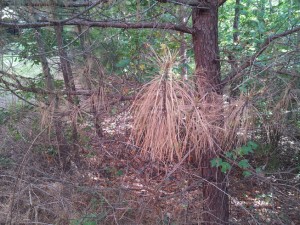
Over the past few weeks, I began to notice that nearly all of the pine trees surrounding my office are starting to turn brown. This seemed quite unusual to me. I would expect one or two to occasionally die but for nearly all of them to be suffering made me wonder if there might be something serious going on.
I decided to send the North Carolina Forestry Service an email with some pictures and see what they said. I got a call back this morning from Randolph Harrison, the ranger for Wake County, giving me the scoop.
Harrison told me he had visited the site and checked out the trees. The main problem, he said, was that the pines are too close together and competing for sunlight. He said that being so low near Crabtree Creek probably saturates the soil around the pines’ roots. Pines don’t do well where there’s flooding, he said.
I had wondered if the trees might be under attack by pine beetles but Harrison said he hadn’t seen any evidence of that. “Believe me,” he laughed. “if you’ve got a pine beetle problem you’ll know it!”
Harrison said the trees are probably suffering from a fungus, fustiform rust, he called it. This turns the trees brown from the ground up. The fungus is another side-effect of the trees being too close together, he said.
I thanked him for his detailed information and later took another look at the trees. The one closest to my office window is about 30% brown. It’s high enough up the hill that it isn’t in the flood plain and I could also not see any of the tell-tale signs of beetle damage. I also could not find any of the fustiform rust gunk that should’ve been on the tree trunk according to the pictures I found on the Internet. And this tree isn’t unreasonably close to other pines.
Was Harrison looking at other trees? Is this a different fungus? Could something else be killing them? I would expect a forestry expert to know what he’s talking about, so I’ll defer to his expertise. It’s been fun trying to figure it out, anyway!